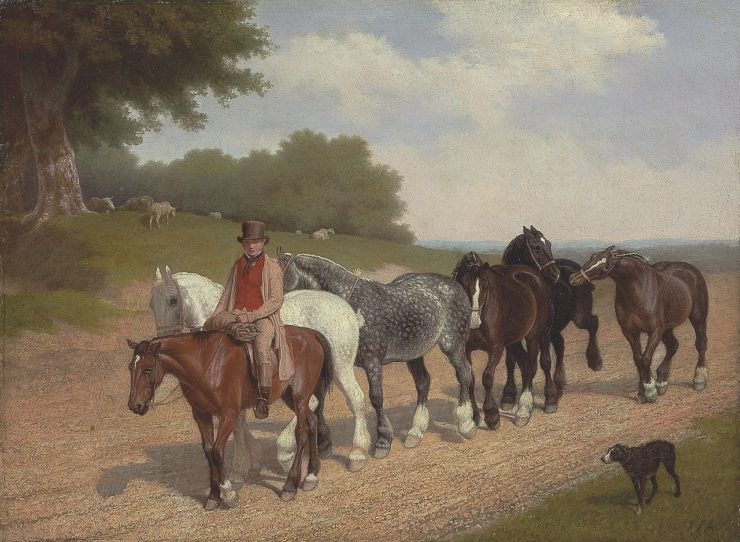Every now and then SFF Equines takes reader questions. (Have one of your own? Ask in comments.) Here is a good one from a reader who presents themself as “not much of a horse person.” They ask:
A very basic question that’s been growing in my mind the more you talk about riding as cooperation. Why does a horse with a human sitting on their back agree to let the human make most of the decisions about where to go? I mean, if you and your horse are heading down the trail on a hot day, and the trail forks with the left branch going to a pleasant, cool pine grove and the right branch going to a meadow where there are some new calves, and you think, “The pines would sure be nice but first I want to check on the calves,” and you say to the horse, “Let’s go right,” hopefully she’s going to agree even if she would prefer some shade. But why would she?
The key to how a horse thinks is what a horse is. A horse is a herd animal. She’s designed to live in groups, to be part of a larger whole.
In the wild, she’s born into a shifting but fundamentally established order, a family grouping of mares and a stallion. It’s not a huge group in general; it can be as small as two or three or as large as twenty or so. That’s about as many mares as a stallion can keep and defend.
There are variations, but this is the basic social structure for horses. Males born into the herd will leave as they mature, to join a bachelor band—a group of unattached, usually young males. These will in turn venture out to win or steal mares of their own and become herd stallions.
The mares meanwhile stay together. Even when they’re lured away by a new stallion, they’re still likely to retain their social order. The lead mare makes decisions for the herd, decides where they go for food and water. The stallion is the defense force, but the lead mare rules. She has her favorites, her lieutenants and her co-rulers.
Subordinate mares move up and down the hierarchy depending on age and temperament. Some are leaders, some are followers. Young leaders, if they’re smart, will defer to their elders, though they will try to push their way up. Young followers may be content to retain their status.
Even leaders can be persuaded to yield to stronger-willed mares. There may be violence—mares fight by kicking, versus stallions, who fight by rearing and biting—but for the most part, one of the combatants will concede. Horse fights are seldom to the death.
And that’s part of what they are. Horses are wired to cooperate. They will defend themselves and they will try to move up in the herd, but the safety of the herd itself requires that its members work together more often than they work against each other.
That includes the stallion. He fights to keep his mares, and to protect them from predators. He may steal mares, but there’s a reason for that: a stallion in the wild is unlikely to breed his own offspring. He may have a secondary stallion with whom he cooperates, and who will breed the daughters and granddaughters. Or an outcross stallion will lure these mares off, while he himself may steal mares from another stallion.
In the herd, the mares decide what happens—and if they don’t want to be bred, it’s a rare stallion who pushes the issue. For one thing, in the act of breeding, the mare is positioned to kick him, and his tender bits, into next week. It’s the mare who lets the stallion know when she’s ready.
It’s all about cooperation. Working together to find food and water, to defend against predators, to raise the young and produce the next generation. Foals in the herd, once past the first few days, are a group effort. They play together, grow up together. Older fillies and mares without foals will help raise them, watch over them and protect them. Then when they’re weaned, they have companions to turn to.
Buy the Book


A Marvellous Light
Domesticated horses can be messed with in awful ways, but the basic wiring is still the same. Horses are wired to cooperate. Trainers will tell you, “A horse wants a leader. She wants someone to tell her where to go.” This is true even of a natural leader. It’s true of stallions as well as mares and the domesticated addition to the horse gender spectrum, the gelding.
This natural tendency, this inclination to cooperate, is what makes horses so amenable to training. It’s been enhanced by breeding over millennia, weeding out the ones who do not cooperate and selecting for those who do. But I think it was there from the beginning, that fundamental good nature, that willingness to follow a leader, even of a different species.
Some training philosophies impose cooperation by force. The horse will do what it’s told or else. This is what you’ll see in movies when the cowboy throws a saddle on the bronc and rides him to a standstill. There’s no finesse. It’s straight-out domination of the animal by the man. Breaking the horse means breaking its spirit. He submits because he has no other choice.
Fortunately, this philosophy has become much less prevalent in the horse world. Trainers concentrate more on gaining the horse’s willing cooperation. They do this by taking it slow, letting her get used to the idea of wearing saddle or harness and going where, and how, the human instructs.
The human does this by winning the horse’s trust. She won’t be asked to do anything she absolutely objects to. If that’s something the trainer wants or needs her to do, they bring her around gradually, show her it’s safe, present it as a desirable outcome.
Walking onto a horse trailer, for example. Small, unstable, dark box is an outright horror for an animal wired to run in wide open spaces. Making it lighter inside still doesn’t make it bigger, but if the trainer puts hay in there, for example, the horse may decide the food outweighs the claustrophobia. Or the horse may trust the trainer so implicitly that she will follow them even into the scariest of places, because the trainer will keep her safe, and good things will come. Food, treats, things she loves to do: run, dance, go places with her person.
I am amazed and deeply humbled by the lengths to which a horse will go for a person she trusts. It’s the same trust she gives her lead mare or her herd stallion. She accepts me into her world and into her herd.
It’s not one-sided, either. The horse always gets a vote. If she objects, it’s my job to figure out why, and to resolve those objections. She may be right: this isn’t a smart thing to do, or she isn’t ready, or I didn’t ask in a way she understood.
As for choosing the shady woods over the calves, that’s not a choice the horse will make. The horse will choose the place where the food and water and safety are. That’s the cow pasture. Nice meadow, good food. Open space. And cows to chase, if that’s her inclination–and for a working cow horse, chasing cows is everything.
Woods are scary for horses. Not only is there little or no good food in there. The trees close in, you can’t see very far, and there could be predators anywhere and everywhere. A horse doesn’t care if it’s cool or shady, she cares if she’ll come out alive.
But, if she trusts me, she’ll go into the woods because I ask. She may snort in alarm and she may be spooky, unless she knows those woods very well. Still, she’ll know that I’ll take care of her, I’ll eventually get her out of the scary place, and there will be rest and food and treats when the ride is over.
That’s our agreement, as horse and rider. Horse carries me where I ask. In return, I feed and care for her, and we get to do things she likes. She likes to go places. She likes to run. She likes to spend time with her person. She may even like that as much as she likes food, if I’ve done my job right: if I’ve won her trust and her willing cooperation.
Judith Tarr’s first novel, The Isle of Glass, appeared in 1985. Since then she’s written novels and shorter works of historical fiction and historical fantasy and epic fantasy and space opera and contemporary fantasy, many of which have been reborn as ebooks. She has written a primer for writers: Writing Horses: The Fine Art of Getting It Right. She has won the Crawford Award, and been a finalist for the World Fantasy Award and the Locus Award. She lives in Arizona with an assortment of cats, a blue-eyed dog, and a herd of Lipizzan horses.










